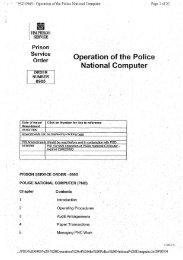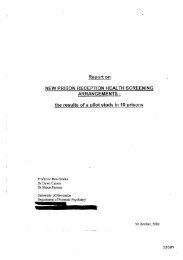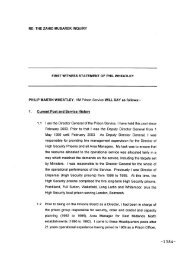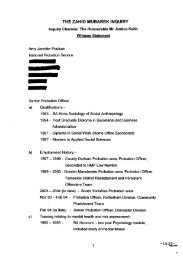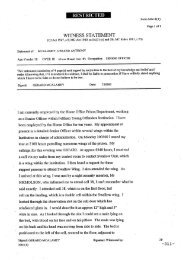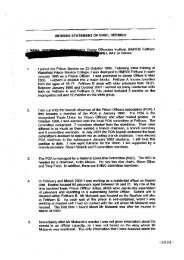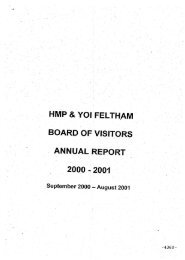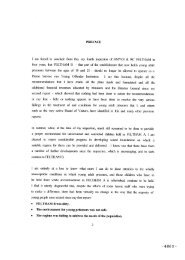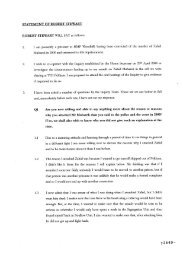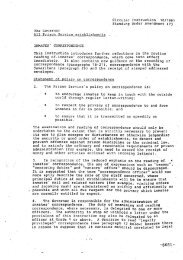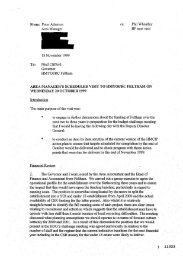Neurotic disorders
Neurotic disorders
Neurotic disorders
You also want an ePaper? Increase the reach of your titles
YUMPU automatically turns print PDFs into web optimized ePapers that Google loves.
Characteristics of young offenders with mental <strong>disorders</strong> ....................................................................................................<br />
the Alcohol Use Disorders Identification Test Tables 9.1 and 9.2. Although there appear to be<br />
(AUDIT). Hazardous drinking was defined as a some differences between those with and without a<br />
score of 8 or more on the AUDIT questions. For personality disorder with respect to some of the<br />
some analyses, this group was subdivided into two: characteristics considered, the base for those with<br />
those scoring 8 to 15 and those reporting very no personality disorder is too low to enable the<br />
heavy drinking and scoring 16 or above, differences between those with and without<br />
personality disorder to reach statistical significance.<br />
However, it is apparent that young offenders who<br />
912.5 Orug dependence classified themselves as white were more likely than<br />
those who classed themselves as black to be<br />
The initial interview contained questions to assessed as having antisocial personality disorder,<br />
establish dependence on cannabis, opiates (heroin with or without other types of personality disorder.<br />
and non-prescribed methadone) and stimulants In contrast the 'other only' personality disorder<br />
(amphetamines, crack and cocaine powder) in the group contained a relatively high proportion of<br />
year before coming to prison as described in young offenders who classed themselves as black.<br />
Chapter 9. For the analyses in this section of the (Tables 9.1 and 9.2)<br />
report, thosewith drug dependence were divided<br />
into four groups based on the type of drugs on<br />
which they reported dependence: 9.4 Characteristics of those with significant<br />
neurotic symptoms<br />
- cannabis only - dependent on cannabis but not<br />
opiates or stimulants The characteristics of those with significant<br />
- stimulants - dependent on stimulants but not neurotic symptoms (CIS-R score of 12 and above)<br />
opiates compared to those without are shown in Tables 9.3<br />
- opiates and stimulants - dependent on both and 9.4. Male remand young offenders with<br />
opiates and stimulants significant neurotic symptoms were less likely to be<br />
- opiates- dependent on opiates but not single than those with CIS-R scores below 12 (66%<br />
stimulants, with CIS-R scores of 12 or more compared with<br />
79% of those with lower scores).<br />
Respondents in these last three groups may or may<br />
not have been dependent on cannabis as well. For There were no significant differences among those<br />
multiple logistic regression analyses with drug with and withou t significant neurotic symptoms in<br />
dependence as the dependent variable, those the male sentenced and female young offenders<br />
dependent on any of these drugs were included as sample groups. (Tables 9.3 and 9.4)<br />
drug dependent.<br />
In the remainder of this chapter, the characteristics 9.5 Characteristics of those repoding<br />
of those with each of the four <strong>disorders</strong> described<br />
hazardous drinking in the year before<br />
above are compared to those without the disorder, coming to prison<br />
It should be remembered that some of the<br />
.- differences seen will be inter-related. Male remand and sentenced young offenders who<br />
Characteristics are listed in the order they appear in reported hazardous drinking before coming to<br />
the tables rather than in order of significance, prison compared with those who did not were<br />
more likely to be White (86% and 87% compared<br />
with 62% and 65% respectively).<br />
9.3 Characteristics of those with personality<br />
disorder The small number of women in the female group<br />
means most of the differences between those who<br />
Thosewith evidence of a personality disorder are reported hazardous drinking and those who did<br />
compared with those without on a number of key not do not reach statistical significance.<br />
socio-demographic and custodial characteristics in (Tables 9.5 and 9.6)<br />
48 Psychiatric Morbidity among Young (]genders in England and Wales -- 7 7 4 2 -




